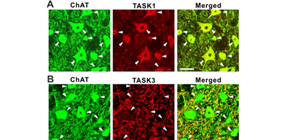
A mechanism behind the molecular neuromechanism of chewing food elucidated
Ion channels responsible for rank-ordered recruitment of motoneurons
When chewing food, the length of jaw-closing muscles is nearly unchanged, so it is thought that isometric contraction of jaw-closing (JC) muscles is occurring. During isometric contraction of JC muscles, motor units are recruited in order of increasing axon diameter of the motor neuron, or increasing conduction velocity. However, the molecular basis related to the rank-ordered recruitment of motor units has not been established in the last 50 years.
TASK (TWIK-related acid-sensitive K) channels are potassium channels that are always activated without being dependent on membrane potential. These TASK channels regulate resting membrane potential and input resistances. TASK channels were highly expressed in motoneurons that govern muscles, so it was thought that these channels played an important role in controlling movements; however, their role was not clear.
A group of researchers led by Specially Appointed Professor KANG Youngnam, Associate Professor TOYODA Hiroki, and Assistant Professor SATOU Hajime of the Department of Neuroscience and Oral Physiology, Graduate School of Dentistry, Osaka University, and SAITO Mitsuru of Kagoshima University, clarified that TASK channels were a molecular basis for controlling rank-ordered recruitment of motor units, and that nitric oxide, a gaseous neurotransmitter, modified TASK channels, thereby modifying rank-ordered recruitment. Masticatory movement as an isometric contraction of muscles is functional and is controlled by a primary sensory neuron, the mesencephalic trigeminal nucleus, which is present in muscle spindles and the brain.
Recently, more children cannot chew hard food because of poor growth of jawbones and jaw muscles. It is not thought that these children swallow hard food without chewing it, but rather, that they are not able to masticate food in the first place, so their normal development of neuromuscular mechanisms is inhibited, which is presented in certain defects.
It is expected that this group’s achievement will help deepen the understanding of mastication motor disorder as well as the importance of guidance and education about preventing this disorder. This group’s achievement is significant in that it elucidated a molecular mechanism of rank-ordered recruitment of motor units (which are dependent on the amount of expression of TSK channels) in the neural network characterized by a functional isometric contraction.
Abstract
Because a rank-ordered recruitment of motor units occurs during isometric contraction of jaw-closing muscles, jaw-closing motoneurons (MNs) may be recruited in a manner dependent on their soma sizes or input resistances (IRs). In the dorsolateral part of the trigeminal motor nucleus (dl-TMN) in rats, MNs abundantly express TWIK (two-pore domain weak inwardly rectifying K channel)-related acid-sensitive-K + channel (TASK)-1 and TASK3 channels, which determine the IR and resting membrane potential. Here we examined how TASK channels are involved in IR-dependent activation/recruitment of MNs in the rat dl-TMN by using multiple methods. The real-time PCR study revealed that single large MNs (>35 μm) expressed TASK1 and TASK3 mRNAs more abundantly compared with single small MNs (15–20 μm). The immunohistochemistry revealed that TASK1 and TASK3 channels were complementarily distributed in somata and dendrites of MNs, respectively. The density of TASK1 channels seemed to increase with a decrease in soma diameter while there were inverse relationships between the soma size of MNs and IR, resting membrane potential, or spike threshold. Dual whole-cell recordings obtained from smaller and larger MNs revealed that the recruitment of MNs depends on their IRs in response to repetitive stimulation of the presumed Ia afferents. 8-Bromoguanosine-cGMP decreased IRs in small MNs, while it hardly changed those in large MNs, and subsequently decreased the difference in spike-onset latency between the smaller and larger MNs, causing a synchronous activation of MNs. These results suggest that TASK channels play critical roles in rank-ordered recruitment of MNs in the dl-TMN.

Figure 1. Complementary distribution of TASK1 and TASK3 channels in motoneurons (MNs) in the dorsolateral part of the trigeminal motor nucleus (dl-TMN).
A , Confocal photomicrographs showing immunoreactivity for ChAT (green) and TASK1 (red) in MNs. As revealed in the merged image, the TASK1 immunoreactivity was seen in somata (filled arrowheads) but not in dendrites. Scale bar, 50 μm. B , Confocal photomicrographs showing immunoreactivity for ChAT (green) and TASK3 (red) in MNs. As revealed in the merged image, the TASK3 immunoreactivity was primarily seen in dendrites but not in somata (filled arrowheads). Scale bar, 50 μm.

Figure 2. Modulation of rank-ordered recruitment of αMNs in the dl-TMN by NO inputs.
To learn more about this research, please view the full research report entitled “ The possible role of TASK channels in rank-ordered recruitment of motoneurons in the dorsolateral part of the trigeminal motor nucleus ” at this page of the eNeuro website.
Related link
